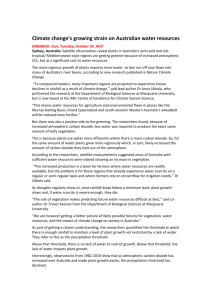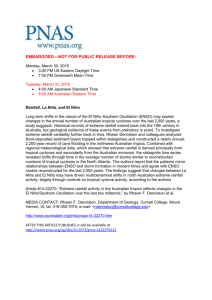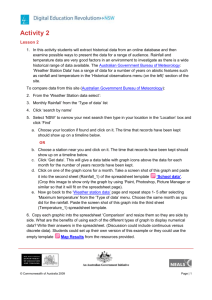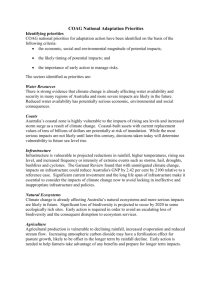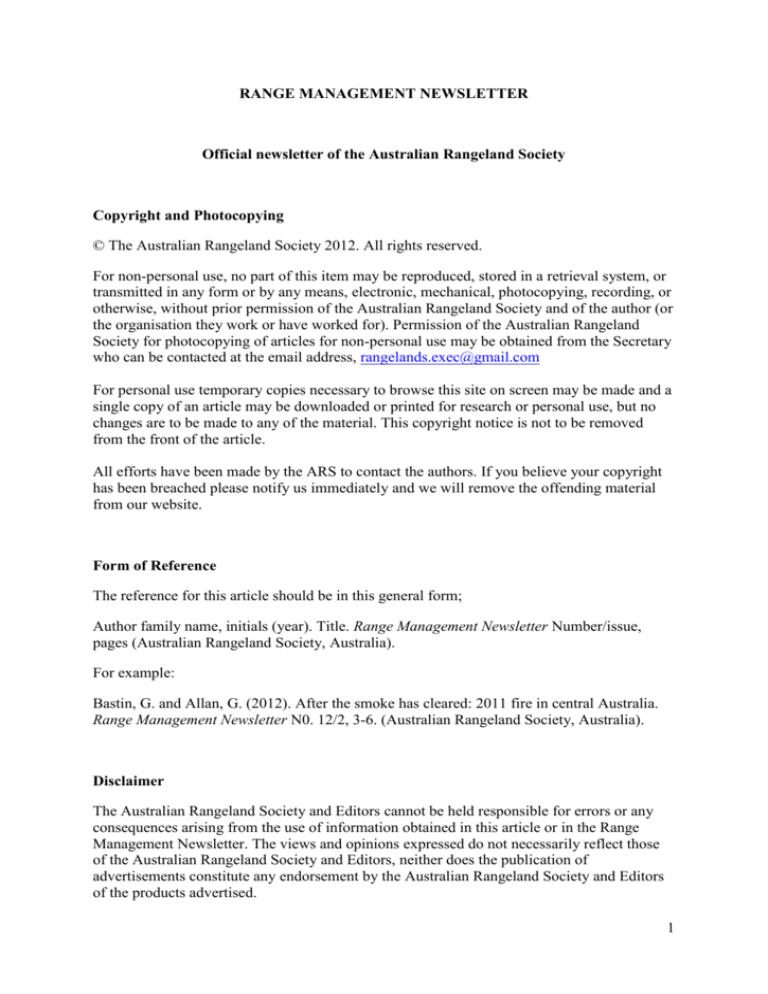
RANGE MANAGEMENT NEWSLETTER
Official newsletter of the Australian Rangeland Society
Copyright and Photocopying
© The Australian Rangeland Society 2012. All rights reserved.
For non-personal use, no part of this item may be reproduced, stored in a retrieval system, or
transmitted in any form or by any means, electronic, mechanical, photocopying, recording, or
otherwise, without prior permission of the Australian Rangeland Society and of the author (or
the organisation they work or have worked for). Permission of the Australian Rangeland
Society for photocopying of articles for non-personal use may be obtained from the Secretary
who can be contacted at the email address, rangelands.exec@gmail.com
For personal use temporary copies necessary to browse this site on screen may be made and a
single copy of an article may be downloaded or printed for research or personal use, but no
changes are to be made to any of the material. This copyright notice is not to be removed
from the front of the article.
All efforts have been made by the ARS to contact the authors. If you believe your copyright
has been breached please notify us immediately and we will remove the offending material
from our website.
Form of Reference
The reference for this article should be in this general form;
Author family name, initials (year). Title. Range Management Newsletter Number/issue,
pages (Australian Rangeland Society, Australia).
For example:
Bastin, G. and Allan, G. (2012). After the smoke has cleared: 2011 fire in central Australia.
Range Management Newsletter N0. 12/2, 3-6. (Australian Rangeland Society, Australia).
Disclaimer
The Australian Rangeland Society and Editors cannot be held responsible for errors or any
consequences arising from the use of information obtained in this article or in the Range
Management Newsletter. The views and opinions expressed do not necessarily reflect those
of the Australian Rangeland Society and Editors, neither does the publication of
advertisements constitute any endorsement by the Australian Rangeland Society and Editors
of the products advertised.
1
After the Smoke has Cleared: 2011 Fire in Central Australia
Gary Bastin, ACRIS Coordinator, CSIRO Ecosystem Sciences, PO Box 2111, Alice Springs
NT 0871
Grant Allan, Bushfires NT, PO Box 2533, Alice Springs NT 0871
Last November, one of us (Grant) reported to an Alice Springs audience on fire activity and
emerging lessons in central Australia during the latter part of 2011. That talk was part of the
2011 Rangeland Journal Lecture Series and is available to Australian Rangeland Society
members (along with those of other guest lecturers) through the Society’s web site.
The fire threat has now eased, at least for the time being, and ACRIS can now report regional
fire activity during 2011 in central Australia relative to other rangeland regions and to
previous years. For those not familiar with ACRIS, it is the Australian Collaborative
Rangelands Information System. Thematic biophysical and socio-economic data and
information about change in the rangelands can be found at our web site,
http://www.environment.gov.au/land/rangelands/acris/index.html.
Data source
Fires are monitored using satellite data. Two web sites are commonly accessed for current
fire activity: the North Australian Fire Information, NAFI
(http://www.firenorth.org.au/nafi2/) and Sentinel
(http://sentinel.ga.gov.au/acres/sentinel/index.shtml). After the smoke has cleared, fire scars
are mapped to determine burnt area, return time or frequency of fire, and other spatial
statistics related to burnt area.
The WA Land Information Authority (Landgate) has mapped fire scars across Australia on a
monthly basis since 1997. Landgate uses data generated by the NOAA AVHRR series of
satellites which has a pixel resolution of 1.1 km x 1.1 km. These large pixels are suitable for
mapping extensive fire but are less sensitive where fires are small or the burn is patchy. The
AVHRR-sourced data are well suited to the rangelands-wide reporting that ACRIS
undertakes.
Wildfire follows big rains
This is an obvious statement for most of the northern savannas, with fires returning each year
during the dry season. Wildfire is more episodic in the arid zone but is related to successive
years of above-average rainfall. The rainfall and burnt-area maps in Figure 1 show
remarkably close spatial coupling between two-year antecedent rainfall and fire extent for the
two most recent big wildfire events in central Australia.
2
≥2500 mm
≤300 mm
2001 fire extent
2011 fire extent
2002 fire extent
Figure 1. Rangeland area burnt in 2001-02 and 2011 (bottom) and cumulative rainfall
between April and March of the two preceding years (top).
Fires in central Australia
ACRIS reports most biophysical data by bioregion or sub-region. There are 52 bioregions
wholly or partly in the rangelands (using the Interim Biogeographic Regionalisation for
Australia, IBRA v6.1). For the six bioregions in central Australia that experienced extensive
fire in 2011, fire was more common between 1997 and 2011 in the two northern IBRAs
(Tanami and Davenport Murchison Ranges, Figure 2) and infrequent in the more arid interior
(Finke and Simpson Strzelecki Dunefields). The location of bioregions is shown in Figure 3.
3
Fire was more extensive in the Simpson Strzelecki Dunefields in 2011 compared to other
years since 1997. Lightning was the primary source of ignitions during both 2001-02 and
2011, but the 2001-02 fires were restricted to the northern portion of the bioregion.
Tanami
70
Davenport Murchison Ranges
10
70
fire
10
fire
rainfall
rainfall
9
60
9
60
8
8
50
6
40
5
30
4
3
20
7
6
40
5
30
4
Decile Summer Rainfall
Decile Summer Rainfall
7
Percent Bioregion Area Burnt
Percent Bioregion Area Burnt
50
3
20
2
2
10
10
1
0
1
0
0
1995 1996 1997 1998 1999 2000 2001 2002 2003 2004 2005 2006 2007 2008 2009 2010 2011 2012
0
1995 1996 1997 1998 1999 2000 2001 2002 2003 2004 2005 2006 2007 2008 2009 2010 2011 2012
Burt Plain
70
MacDonnell Ranges
10
70
fire
10
fire
rainfall
rainfall
9
60
9
60
8
8
50
40
5
30
4
3
20
7
6
40
5
30
4
Decile Summer Rainfall
6
Decile Summer Rainfall
7
Percent Bioregion Area Burnt
Percent Bioregion Area Burnt
50
3
20
2
2
10
10
1
0
1
0
0
1995 1996 1997 1998 1999 2000 2001 2002 2003 2004 2005 2006 2007 2008 2009 2010 2011 2012
0
1995 1996 1997 1998 1999 2000 2001 2002 2003 2004 2005 2006 2007 2008 2009 2010 2011 2012
Finke
70
Simpson Strzelecki Dunefields
10
70
fire
rainfall
10
fire
rainfall
9
60
9
60
8
8
50
40
5
30
4
3
20
7
6
40
5
30
4
3
20
2
10
Decile Summer Rainfall
6
Decile Summer Rainfall
7
Percent Bioregion Area Burnt
Percent Bioregion Area Burnt
50
2
10
1
0
0
1995 1996 1997 1998 1999 2000 2001 2002 2003 2004 2005 2006 2007 2008 2009 2010 2011 2012
1
0
0
1995 1996 1997 1998 1999 2000 2001 2002 2003 2004 2005 2006 2007 2008 2009 2010 2011 2012
Figure 2. Percentage of IBRA area burnt each calendar year and decile summer rainfall
(November-April) for six bioregions in central Australia.
Similar areas of the Finke bioregion were burnt in 2002 and 2011, but the spatial patterning
was different. Extensive areas of pastoral land south of Alice Springs were not burnt last
4
year and have a high fire potential in 2012. Fire was mostly absent in the Finke bioregion in
other years.
Further north in the southern NT, similar proportions of the MacDonnell Ranges and Burt
Plain IBRAs burnt in 2011 compared with the combined extent of fires in 2001-02. In both
bioregions, the previous big fire season extended over two calendar years, i.e. a considerable
proportion of the Burt Plain burnt in 2001 (less so in 2002) and parts of the MacDonnell
Ranges also burnt in 2001. This pattern continued further north in the Tanami and Davenport
Murchison Ranges IBRAs with a proportionally large area burnt in 2011, considerable
portions burnt between 2000 and 2002, and >15% of IBRA area burnt in some of the
intervening years. The fires during 2006-07 were associated with two-years of aboveaverage rainfall in these northern bioregions of central Australia but the rainfall did not
extend as far south as Alice Springs and influence the fire potential of the four southern
bioregions.
DMR
TAN
BRT
Figure 3. Location of central
Australian bioregions used for
reporting 2011 fire statistics.
MAC
SSD
FIN
BRT
DMR
FIN
MAC
SSD
TAN
Burt Plain
Davenport Murchison Ranges
Finke
MacDonnell Ranges
Simpson Strzelecki Dunefields
Tanami
Fire activity in 2011 was concentrated between August and November (Figure 4) although
the fire season started a little earlier in the northern bioregions. With the exception of several
fires started by lightning in late January, the majority of the fire activity between March and
July was prescribed burning undertaken to reduce fuel loads and protect assets ahead of the
expected high fire potential across central Australia later in the year.
After the fires
It is difficult to directly compare the 2001-02 fire season with that of 2011, although the
combined spatial extent of the fires was similar. The fires in 2001 were primarily north of
Alice Springs and persisting soil moisture and post-fire rainfall helped pasture recovery. In
contrast, the 2002 fires occurred at the end of the period of above-average rainfall. In
5
general, many of the 2002 fires had a greater impact on the woody vegetation communities
and pasture recovery was restricted by the dry conditions that followed (indicated by decile
rainfall values for bioregions in Figure 2). At a particular location, Alice Springs received
below-average rainfall for the seven-year period from July 2003 to June 2009.
70
70
Tanami
50
50
Percent Bioregion Area Burnt
60
Percent Bioregion Area Burnt
60
40
40
30
30
20
20
10
10
0
0
1997
1998
1999 2000
2001
70
2002 2003
2004
2005 2006
2007
2008 2009
2010
2011
1997
1998
1999 2000
2001
70
Burt Plain
50
50
2002 2003
2004
2005 2006
2007
2008 2009
2010
2011
2007
2008 2009
2010
2011
MacDonnell Ranges
Percent Bioregion Area Burnt
60
Percent Bioregion Area Burnt
60
40
40
30
30
20
20
10
10
0
0
1997
70
Davenport Murchison Ranges
1998
1999 2000
2001
2002 2003
2004
2005 2006
2007
2008 2009
2010
2011
Finke
1997
70
50
50
1999 2000
2001
2002 2003
2004
2005 2006
Simpson Strzelecki Dunefields
Percent Bioregion Area Burnt
60
Percent Bioregion Area Burnt
60
1998
40
40
30
30
20
20
10
10
0
0
1997 1998 1999 2000 2001 2002 2003 2004 2005 2006 2007 2008 2009 2010 2011
1997 1998 1999 2000 2001 2002 2003 2004 2005 2006 2007 2008 2009 2010 2011
Figure 4. Percentage of IBRA area burnt each month throughout 2011 for six bioregions in
central Australia.
It is too early to determine the ecological implications of the 2011 fire season and further
fires that are anticipated in 2012. To date, the direct effect of the 2011 fires on the pastoral
industry appears to be more subdued than those of 2002, although the cost of fire response in
both years was significant. Above-average rainfall this past summer appears to have
promoted good ground cover across much of the country burnt last year and allowed affected
6
pastoralists to maintain their grazing enterprises without enforced destocking. However there
is potential in many areas for a second, short-interval, fire season. In contrast to 2011, these
follow-up fires should be more localised and primarily in run-on areas, areas that have
received higher localised rainfall and areas of dense buffel grass (Cenchrus ciliaris). The
impact of these short-return fires on pastoral enterprises and landscape ecology is uncertain.
More generally, fires are anticipated on pastoral land unburnt in 2011. The likely return to
more ‘normal’ conditions of highly variable rainfall could mean reduced pasture recovery
post these fires. Beyond the pastoral country, fires are also anticipated on Aboriginal-held
land in the south western NT (Great Sandy Desert and Central Ranges bioregions) following
above-average rainfall between 2010 and 2012 and the recent absence of extensive fire in
2011. Fortunately this tri-state border region recently received funding assistance through the
Australian Government Caring for Our Country program to help Aboriginal land managers to
collaboratively manage fire to reduce the risk of large scale wildfires, retain and improve
biodiversity, protect threatened species habitat and protect significant cultural assets.
Last word
Fire activity in central Australia in 2011 demonstrated the positive outcomes of research
conducted by the Desert Knowledge Cooperative Research Centre in the mid ‘noughties’
(Turner et al. 2008, Edwards et al. 2008). In particular, the data confirm that extensive
wildfire follows successive years of high summer rainfall. The largest areas were burnt
between August and November with fire activity abating in December with the return of
moderate rainfall (>10 mm falling over much of inland Australia, see
http://www.bom.gov.au/jsp/awap/rain/archive.jsp?colour=colour&map=totals&year=2011&
month=12&period=month&area=nat, accessed 28 May 2011).
Despite the extensive area burnt in 2011, the future remains bright. The capacity for
prescription fire management increased substantially between 2002 and 2011. The greatest
increase was associated with the extensive areas of Aboriginal Land Trusts through the
Indigenous Ranger program of the Central Land Council. The prescriptive fire program on
NT parks and reserves has been maintained over the past decade. Both groups undertook
aerial burning in 2011. Although staff struggled to match the scale of prescriptive programs
to the anticipated fire potential across the extensive area of central Australia, the continued
expansion of the ranger programs will provide significantly more capacity to deal with future
fire events.
Acknowledgements
ACRIS purchased rangelands-wide fire data from the WA Land Information Authority
(Landgate) with funding from the Australian Government through its Caring for our Country
program. This funding is managed by Ninti One Ltd.
References
Turner, D., Ostendorf, B. and Lewis, M. (2008). An introduction to patterns of fire in arid
and semi-arid Australia, 1998-2004. The Rangeland Journal, 30, 95-107.
7
Edwards, G.P., Allan, G.E., Brock, C., Duguid, A., Gabrys. K. and Vaarzon-Morel, P. (2008).
Fire and its management in central Australia. The Rangeland Journal, 30, 109-121.
8


